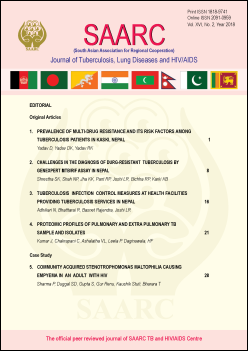Prevalence of multi-drug resistance and its risk factors among tuberculosis patients in Kaski, Nepal
DOI:
https://doi.org/10.3126/saarctb.v16i2.23336Keywords:
Tuberculosis, multidrug resistance, directly observed treatment short courseAbstract
Introduction: Multidrug-resistant tuberculosis is an intense and feared problem, difficult to control and has shown a trend of increase worldwide. MDR-TB poses a therapeutic and infection control challenge with significantly higher rates of morbidity and mortality. Hence, this study was conducted with objective to assess prevalence of multidrug resistance and its risk factors among Tuberculosis patients in Kaski district.
Methods: The main component of the study comprised institutional based cross sectional study design which was conducted in directly observed treatment short course (DOTS) centers in Kaski district. The study period was from July 2016 to December 2016. The sample size for the study was 175 participants. Data collection was done through interview with used interview schedule, and review of patient treatment cards. Data were entered in Epidata software and analyzed by using SPSS 20 version software.
Results: The prevalence of multidrug resistance in Kaski district was 5.7 per cent. Variables such as TB history in past, TB treatment in past, and cured in past are found statistically significant (p<0.005). People with prior history of TB were shown to be 19 times more likely to get MDR TB than those with no prior history (OR=19.056, CI: 4.522-80.294). People with complete TB treatment in past were 0.2 times less likely to get MDR TB than those with incomplete TB treatment in past (OR=0.182, CI: 0.075-0.441).
Conclusion: Present of previous TB infection and prior treatment outcome (to be defaulted or failed in treatment) were also identified as the risk factors for developing MDR TB. Proper surveillance system is to be established in terms of complete treatment to all TB patients that leads the prevention from MDRTB and prevent potent expensive costs from medical care for MDRTB patients.
Downloads
Downloads
Published
How to Cite
Issue
Section
License
Copyright © SAARC Tuberculosis and HIV/AIDS Centre (STAC), all rights reserved, no part of this publication may be reproduced, stored in a retrieval system or transmitted in any form or by any means without prior permission of the STAC.





